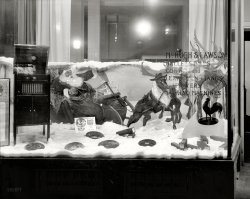
MAY CONTAIN NUTS

Search Shorpy
SHORPY ART

Framed or unframed, desk size to sofa size, printed by us in Arizona and Alabama since 2007. Explore now.
Join and Share
Ad-Free Shorpy
Shorpy is funded by you. Patreon contributors get an ad-free experience.
Learn more.

Recent comments
- Recent view
- Hudson’s Big Store
- Say what??
- Grapes?!
- A Beautiful Moment
- Such joy
- Bethune-Cookman University today...
- Yellow sky at morning
- Side Winder
- Air Quality?
- Sojourner Truth riot
- None were so blind(ed)
- The less famous sister
- Good ol' days?
- Rise and Fall
- Goo Goo Ga Joob
- Ticket Retention
- Not the only one
- Vagaries of War
- Killed by Amtrak
- Back to the Future
- Wanted --
- If you can't stand the light
- Centralized Traffic Control, I believe
- What's really happening
- Heckuva remote control!
- Sometimes — Things Go Bump!
- I SEE THE LIGHT
- Union Switch and Signal Company
- Get That Light Out Of My Eyes
Member Photos
The Shorpy
Print Emporium
Print Emporium
Search Shorpy
Search results -- 30 results per page
- Fountain House: 1899
- ... tasted like Kool-Aid (they tasted like licking an iron pipe, of course!).
(The Gallery, DPC) ... Posted by Dave - 08/15/2012 - 4:36pm -
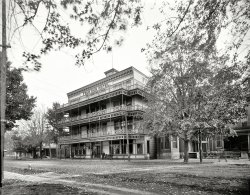
- River Coal: 1910
- ... a rectangular well built into the side of the hold, with a pipe going down to the bilge. A clear example is at the lower left corner, on barge 2277.
The configuration of the top of the pipe, with a smaller pipe from the pump barge coming in the back of the elbow, ... Posted by Dave - 01/31/2014 - 9:35am -
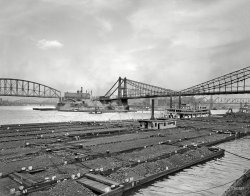
- The Stamp Mill: 1906
- ... Apparently they are pumping houses through that big pipe.
[The houses are an exact match for another Shorpy image -- who'll ... Posted by Dave - 07/28/2013 - 10:16pm -
![The Stamp Mill: 1906 Copper production circa 1906. "12,000 horsepower compound pump, Calumet and Hecla stamp mill, Lake Linden, Michigan." Note the faint double exposure in this 8x10 inch glass plate. Detroit Publishing Company. View full size.
Enter Charlie ChaplinLooks like the movie Modern Times could have been shot there.
The Main Bearingmust have required constant attention as evidenced by the captain's chair on the platform. Employees of the era were rarely offered the opportunity to sit while on the job.
It brings to mind a John Lennon lyric from a 1980 song "I'm just sittin' here watching the wheels go round and round, I really love to watch them roll."
The steam engine is a work of art but so, too, is the building with its myriad girder and truss work. Note the sloping outer walls fit to the angle bracing and that huge overhead hoist! Another fascinating Shorpy view!
Sitting roomI found two other chairs, just to the right of the big wheel, one on the top platform and one on the bottom.
Domestic plumbingApparently they are pumping houses through that big pipe.
[The houses are an exact match for another Shorpy image -- who'll be the first to find it? - Dave]
The First Exposure or the Second?I propose The Heart of Copper Country: 1905 as the second exposure on the above photo.
[We have a winner. -tterrace]
Way ta go!Congrats to Orange56! Good eye!
CraneCan anyone make out the manufactures sign on the Overhead crane? Thanks in advance
(Technology, The Gallery, DPC, Mining)](https://www.shorpy.com/files/images/SHORPY_4a13097a.thumbnail.jpg)
- Old-School: 1953
- ... indigo dye in brand new blue jeans
*A whiff of Cavendish pipe smoke coming from the principal’s office
*Sweaty kids – not the ... Posted by Dave - 07/20/2015 - 10:17pm -
![Old-School: 1953 Jan. 29, 1953. "Greenville School, town of Greenburgh, New York. Foyer." At right, "Third Grade Paintings." 5x7 negative by Gottscho-Schleisner. View full size.
FamiliarI'm sure this looks familiar to Shorpyites of a certain age - it looks just like my elementary school in Michigan. Most of the 50's and 60's schools seemed to share the same DNA. Many of those windows were blocked off and insulated in the panic of the oil crisis in the '70s.
Natural Light EverywhereThe complete LOC set is fascinating. Love these midcentury school designs, with abundant natural light in classrooms--and windows that open!--very unlike classrooms in the school where I teach (built in the 1990's). For the nerdiest among us, here is an interesting history of school design 1900-present.
Academic AromasAhhh, the scent of a mid-century American elementary school. Our sense of smell and the way our brains organize memory (the olfactory bulb is part of the brain's limbic system) are very closely related; aromas can call up memories and powerful responses almost instantaneously. I guess it works in reverse, too, because seeing this school scene caused ghost scents to appear in my office this morning as I indulged my coffee and breakfast taco and Shorpy habits. The phantom aromas have to be strong to overpower a taco and cup of Ruta Maya…but here’s what I detected:
*The indigo dye in brand new blue jeans
*A whiff of Cavendish pipe smoke coming from the principal’s office
*Sweaty kids – not the sourly rank teen kind, but the innocent 4th grade kind
*Mimeograph ink
*Fish sticks and sheet cake from the cafeteria
*Wood shavings from the pencil sharpeners
*Bic pen ink
*Cardboard Duo-Tang folders
*Cut grass from the playground
*Crayola crayons and construction paper
*An olfactory stew of gum eraser, chalk dust, and Elmer’s glue
*Ms. Borcherding’s rose petal perfume and Aqua-Net hairpspray
And perhaps my most vivid olfactory memory: the faintest hint of “Charlie” perfume, booze and cigarette smoke wafting around the hot-before-I-knew-what-hot-was library assistant Ms. Sherri D’Amato (Cherry Tomato).
Goober Pea
Re: Academic AromasOne more: that green stuff the janitor threw on the floor before he swept.
ackModernist architecture and, yes, I went to schools very similar to this. They were, like most modernist designs, stiff, cold, and boring.
In this picture, gaze with head shaking at the Danish modern furniture, which I think was designed to be as uncomfortable and unattractive as possible.
Thank you. It's good to get that off my chest!
More than familiarThis doesn't look like my elementary school, this WAS my elementary school. I went to kindergarten here in 1955. I was put into shock this morning when I woke up to this photo. Funny, the only thing I remember were the naps. My brother went there too.
Hey, that's my schoolWhat a surprise today at my daily glimpse of Shorpy as I saw "my" Greenville School where I attended second through fourth grades from 1950-54. That Shorpy would single out such a relatively insignificant school in of all in the country seemed a bit strange so I did a double take to see that it was actually "my" Greenville School. Although I walked past the furniture in the foyer every day, my memory does not recall it after 62 years, yet that memory clearly remembers riding rain, snow, or shine on a 1950 English 3-speed Rudge bicycle to school every day. I rode that Rudge through 1970 in college. The Greenburg area of Scarsdale was a wonderful place to grow up.
Strangely, it was a 1958 photo of my new Redwood High School in Larkspur, CA that was posted on Shorpy some years back that got me to looking at Shorpy every day. Great site and many memories.
[You're in my 1961 Redwood Log yearbook, your senior year, my freshman. I posted that 1958 Redwood photo my brother took. -tterrace]
My Thoughts Exactly, Gooberpea!Upon seeing this photo of what could've been my elementary school at Kincheloe AFB, Michigan I too was overwhelmed with "aromatic" memories. I giggled to myself while thinking, "I wonder if anyone else associates memories with smells", and all at once I read your post, Goober Pea. Apart from Ms. Cherry Tomato, you got it, exactly!
Academic Aromas IIMy elementary school had similar smells as Gooberpea mentioned except for Ms. Borcherding’s rose petal perfume and Aqua-Net hairpspray since mine was the Shrine of the Little Flower.
No parochial student of my era '46-'52 could ever forget the smell of a rainy Friday. There was the aroma of wet boys' cudoroy school pants mingled with the aromas of the brown bag Catholic lunches of that era. Hardboiled eggs, fried eggs, salmon croquettes, fried fish and for a lucky few crab cakes created a meatless miasma of unforgettable smells.
(The Gallery, Education, Schools, Gottscho-Schleisner)](https://www.shorpy.com/files/images/SHORPY-5a17424u.thumbnail.jpg)
- Metropolis in Ruins: 1906
- ... The pipes across the street match the location of a pipe storage yard that would have been behind "lodgings"; the building to the ... Posted by Dave - 10/31/2013 - 11:46am -
![Metropolis in Ruins: 1906 "Panorama from roof of Ferry P.O., San Francisco." Aftermath of the April 1906 earthquake and fire. 8x10 glass negative, Detroit Publishing Co. View full size.
Quake survivorsSome relics of the earthquake and fire survive to this day, thanks to them having sunk below the surface; see this story.
Enormous scaleThere are a few men and one horse cart visible on the dirt road in about the middle of the photo. We have no idea what massive destruction resulted from this earthquake.
Today, we'd have all types of cars and developed structures broken and twisted, but these are millions upon millions of bricks and blocks and simple wood pieces, throw around like toothpicks.
I've never thought the few SF earthquake photos I've seen have shown the intensity that resulted. Those tiny people amid all that mayhem prove that's true.
[The subsequent fire rather than the earthquake itself is by far the greater cause of the destruction seen here. -tterrace]
WowWhat is that monstrous piece of machinery behind the leftmost walking man?
Re: MachineryI see gears and what looks like a flat pulley for a belt possibly parts of an Elevator system?
Inflammable NeighborhoodsThe Ferry Post Office was just south of the Ferry Building along the Embarcadero; the building was built in 1900-1901, and rebuilt at the same site in 1915; the 1915 building still exists. Based on that location, the photo is looking over the Embarcadero; the street is Steuart Street, with Spear behind. Market Street would be just to the right of the photo, Mission Street to the left.
A 1898-era Sanborn map shows that the ruins with the steel columns on the facade was probably the Seaman's Institute; the near side of the building would have been a ship's chandlery. The pipes across the street match the location of a pipe storage yard that would have been behind "lodgings"; the building to the left with the big gear/pulley would also have been a ship's chandler, suggesting the big machinery was a ship's windlass. The four story building one street back that looks intact would have been the U.S. Commissary Department at Spear and Mission.
This area would have burned well thanks to all the industries catering to the shipping trade. Spear was lined with Allen and Higgins Hardwood Lumber, California Mills Lumber House, and the California Planing Mill. On the near side of Spear, there were multiple hay lofts and a lumber yard.
Along the street we can see, we would ave had a row of lodgings, and on the near side, ships chandleries, saloons, stores, etc.
Sanborn San Francisco 1899-1900, vol. 2, sheet 126.
Much more high-rent nowThe location of the photo (between Market and Mission, Steuart and Spear) got a lot more high-rent after the earthquake; this became the site of the Southern Pacific's headquarters building (now known as 1 Market St.). SP had some grand plans to build a great train station behind the building and across the center of this photo, but never quite had the money to get the main line tracks over here. A pair of high-rises eventually ended up behind 1 Market St.; now, it's the home of Salesforce.com.
What a difference six months makes!BTW, here's the scene a block to the right six months later. Note that the U.S. Commissary building is still standing, but the other blocks have already been cleared and replaced by new low-rise structures.
(The Gallery, DPC, Fires, Floods etc., San Francisco)](https://www.shorpy.com/files/images/SHORPY_4a13222a.thumbnail.jpg)
- Housing Boom: 1923
- ... over the entire block, a wooden match flaring to light a pipe and a streak of fire as a cigarette was flicked away to land in the gutter ... Posted by Dave - 09/11/2011 - 1:18pm -
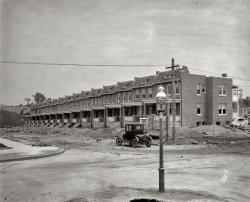
- Jaunty Joe: 1923
- ... Perhaps he is a landscaper, pilot, male model and pipe connoisseur.
The Grin Raker He kind of reminds me of the comic book ... Posted by Dave - 03/15/2014 - 11:54pm -
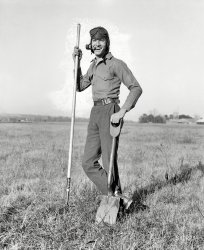
- Newsstand Noir: 1957
- ... No Cool Hand Lukes roaming around lopping them off with a pipe cutter though.
Body language That looks like the pose taken by my ... Posted by tterrace - 05/21/2015 - 1:26pm -
![Newsstand Noir: 1957 My brother snapped this 35mm Kodak Tri-X negative as a former high school classmate left (Fled? Took it on the lam?) from this newsstand at 1241 Fourth Street in San Rafael, California. At the time this was one of two newsstands downtown. That was in addition to Montgomery Ward, J.C. Penney, Macy's plus all the other kinds of stores that made San Rafael the major shopping spot for Marin Country - that is, until shopping centers started popping up a few years later.
If I didn't know better, I'd think that guy might have been Elvis. View full size.
Speaking of parking metersI remember one evening a bunch of us were hanging out at the Foster's Freeze when a car, obviously out of control, jumped the curb and knocked down a parking meter (at the same exact place incidentally that the cop car was de-axled in "American Grafitti"). The car backed up and sped away at which time we dashed for the meter and took it up the hill to disgorge its contents. After an hour of bashing it refused to give up its booty and for all I know the meter is still up on the hill in back of Foster's Freeze. Our adventure didn't make it into the movie.
Fourth Street holds many memoriesThe Rafael Theater where some serious necking was done. Next door, the Navy recruiter where I solemnly vowed to protect my country in 1962. J.C. Penney's where I bought most of my clothes. The two auto parts stores across the street from each other where I furnished my 1957 Ford F-100. And not to forget the Friday and Saturday night cruises where the county gathered from Highway 101 to Foster's Freeze and back again countless times. It was a great place to spend my senior year.
2 things you don't see anymoreTypewriters
Parking meters
White wall tires
Barber poles
[And then some. -tterrace]
Parking metersDon't know about whitewall tires, barber poles or typewriters, let alone Elvis, but downtown San Rafael is still loaded with parking meters. No Cool Hand Lukes roaming around lopping them off with a pipe cutter though.
Body languageThat looks like the pose taken by my high school pals when leaving a store that had sold beer to the underaged. You know, hiding it under the coattail as if nobody would notice it or him. Saw it a hundred times, hehe.
Elvis confusionI have to agree with your comment about Elvis; at first glance I thought it was him too. I don't doubt it will eventually find its way into the fan circles misconstrued as a long-lost unreleased candid. Cool pic nonetheless.
(ShorpyBlog, Member Gallery, tterrapix)](https://www.shorpy.com/files/images/newstandnoir.thumbnail.jpg)
- Vaudeville News: 1927
- ... in the know. Is that a fire extinguishing system along the pipe in the top of the picture? Also, the noose in the wire in the back: is ... The fire extinguisher system is an automatic system. The pipe is pressurized with water, and if fire melts a small meltable link in the ... Posted by Dave - 02/27/2012 - 11:38pm -
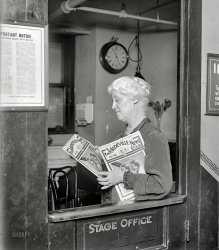
- Army Elbow: 1942
- January 1942. Louisville, Kentucky. "Large pipe elbows for the Army are formed at Tube Turns Inc., by heating lengths of pipe with gas flames and forcing them around a die." 4x5 Kodachrome ... Posted by Dave - 08/10/2012 - 7:49pm -
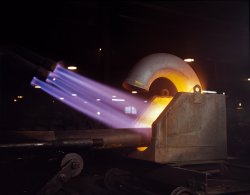
- Veteran Park: 1900
- ...
Ghost watcher Man on the left, quietly smoking his pipe as the apparition passes by.
Syracusan periods It seems that ... Posted by Dave - 08/21/2012 - 6:31pm -
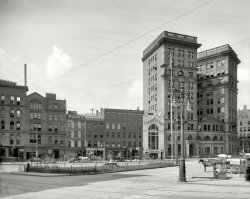
- Hotel Escambia: 1910
- ... the very steep roof to the edge, grab hold of the roof pipe fence and hopefully can carefully walk to the front second floor fire ... Posted by Dave - 08/14/2012 - 8:11pm -
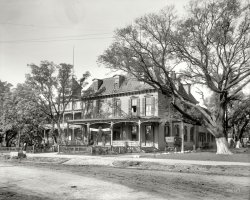
- The Big Dig: 1910
- ... the steam was ejected after each piston stroke through the pipe at the top of the rig. Consequently a steady supply of boiler feed water ... Posted by Dave - 08/21/2012 - 5:57pm -
![The Big Dig: 1910 "Steam shovel removing rock loosened by dynamite, Livingstone Channel, Michigan." Construction of the navigation channel along the Detroit River circa 1910. 8x10 inch glass negative, Detroit Publishing Company. View full size.
More news herehttps://www.shorpy.com/node/10126
[Also some more old steam shovels here. - Dave]
What a shovelI never really thought about it but steam shovels like this one did not have a steam condenser,so the steam was ejected after each piston stroke through the pipe at the top of the rig. Consequently a steady supply of boiler feed water would have been necessary, and if the local water was hard cleaning the boiler tubes must have been a headache. Other than that there is an overhead tram for removing the excavated soil to a distant dump location.
Mike Mulligan and Mary AnneA few years later, Popperville would need a new town hall, and the rest is history.
Digging with steam?That looks like high pressure steam being released at the end of the boom. But then again, there is a long snaking hose running off to the right of the picture, Maybe they are using high pressure water to loosen rocks?
Marion Steam ShovelThe steam shovel appears to be a converted 'railroad-type,' built by the Marion Steam Shovel Co. of Marion, Ohio.
(The Gallery, DPC)](https://www.shorpy.com/files/images/SHORPY_4a18891a.thumbnail.jpg)
- D.C. DJ: 1931
- ... early days of sound pictures. They could also be used to pipe radio into the cinema. - Dave]
Victor Home Recording Blank From ... Posted by Dave - 04/18/2014 - 10:03am -
![D.C. DJ: 1931 Washington, D.C., 1931. "Man with portable radio receiver and phonograph." Who seems to be using the amplifier to play a record into a microphone. Note handy "Radio Spectrum" chart. Harris & Ewing glass negative. View full size.
Two turntables and a microphone This is an amazing 39 years before Beck was born
Heavy, dude, heavy...Those cartridges and headshells look like they weigh at least 16 pounds - hope those records are made of something a little more substantial than acetate...
Spectrum chartI would love to get a close look at that spectrum chart. In 1931 40 megahertz ("megacycles" in those days) was about the limit of radio technology. Today I have a spectrum chart on my wall that goes to 150 gigahertz. That's 150,000 megahertz.
Electrical TranscriptionActually, what is happening here is the production of an electrical transcription. The disk isn't being played into the microphone--it's going the other direction. The radio broadcast is being recorded onto the disks for playback later or for archival purposes.
When I worked in radio in the early eighties, there was still a check box on the daily log to indicate that the audio source was "ET." I suspect things have caught up by now.
[The turntable is an RCA Photophone similar to the "Theatre Phonograph" in the illustration below. These were used to play background music during seating and intermission in the early days of sound pictures. They could also be used to pipe radio into the cinema. - Dave]
Victor Home Recording BlankFrom the label I can identify the record as a Victor Home Recording blank. The plastic records were pre-grooved, so the recording process was done by embossing, not cutting. It's a little harder to judge, but from the photo it looks like the grooves are already modulated, so we're seeing the record being played back.
Surprisingly lightI have a working 1933 RCA Victor combination radio phonograph with a very similar tone arm and thumb screw needle. I don't know if it's made of aluminum or pot metal, but it doesn't weigh nearly as much as it looks as though it would. I wouldn't try it on a 1950s or newer plastic record, but it does well playing both the pre-war shellack and Durium cardboard Hit Of The Week 78s of that era.
Federal Radio Commission recorderThis description is from a news photo in 1931:
A new type of portable radio recorder has been invented. The apparatus is a portable disc equipment consisting of two motor-driven turntables, a recording amplifier, a nmicrophone, radio receiver and a loudspeaker. Pre-grooved blank disc records are placed upon each of the turntables, and when in operation, with sound being recorded as it emanates from a loudspeaker, the records operate continuously and automatically change from one to the other. This device is expected to help the Federal Radio Commission in settling any problems of programs on the air, having had to use stenographic reports until now.
(Technology, The Gallery, D.C., Harris + Ewing)](https://www.shorpy.com/files/images/SHORPY_36509a.thumbnail.jpg)
- On Vacation: 1969
- ... studied classical piano from about age 6, and branched to pipe organ at 12, I play violin and viola also because three weeks into my HS ... Posted by Mvsman - 09/18/2011 - 10:16pm -
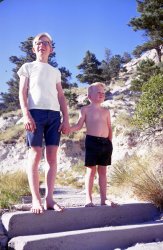
- Swim Class: 1905
- ... it is slightly wider than all the rest. It seems to have a pipe attached to it.
It must have been to pipe fresh water, either from a well or more likely a pipe leading from shore ... Posted by Dave - 06/05/2014 - 3:06pm -
![Swim Class: 1905 Florida circa 1905. "Surf bathing at Palm Beach." No ocean was ever a prettier shade of gray. 8x10 glass negative, Detroit Publishing Company. View full size.
A water windmill On a pier. Why?
[Generate power for whatever goes on in that building? -tterrace]
Help me into the water too, please!Okay, that guy in the front helping his son (daughter?) navigate the waves is a definite hottie in my book (the biceps alone--woweee). Rather tricky to deal with a crush on a man over 130 years old though, so I will just admire how he nicely fills out his bathing suit from a distance -- a very loooong distance.
The windmillIf you follow a line down from it you can see that the pylon below it is slightly wider than all the rest. It seems to have a pipe attached to it.
It must have been to pipe fresh water, either from a well or more likely a pipe leading from shore to that hut.
In any event it is not the sort of windmill one would use for generating electricity. They had been developed in Denmark about 15 years before this but they were MUCH larger.
from 1889:
(The Gallery, Boats & Bridges, DPC, Florida, Kids, Swimming)](https://www.shorpy.com/files/images/SHORPY-4a16360a.thumbnail.jpg)
- Made in America: 1942
- ... used to cook food at the tableside and has a vent pipe but I don't believe I have ever seen anything like it. How was it used? ... Posted by Dave - 10/03/2017 - 12:11pm -
![Made in America: 1942 June 1942. Chicago, Illinois. "Manpower. Americans all. His war job with Pressed Steel Can Car Company gives Michael Kassalo an extra good appetite. Operating a vertical turret lathe in a Midwest tank plant, Michael is one of many hundreds of first- and second-generation Americans whose sole purpose during working hours is to get as many tanks as possible off the lines and ready for shipment to the fighting fronts. Michael's grandparents, with whom he lives, cling to the Slavic language and to many 'Old Country' customs, but Michael and his brothers and sisters are as American as the Smiths and Joneses." Photo by Ann Rosener for the Office of War Information. View full size.
Pressed Steel CAR Co.The original photo caption seems to have a typo. It most likely meant to reference the Pressed Steel Car Co., which was a major builder of railway equipment and did indeed convert to the production of tanks and other armored vehicles during the war. They had factories in Illinois as well as Pittsburgh.
Tableside ApparatusCan anyone please tell me what the apparatus in the foreground is? It looks like something used to cook food at the tableside and has a vent pipe but I don't believe I have ever seen anything like it. How was it used? Very interesting picture.
Michael reaches for ...... a handful of jellyfish?
What IS that stuff?
[He's reaching into a cellophane bag or wrapper. -tterrace]
[For a slice of "California-Style" HoneyWheat Bread. - Dave]
Laundry stoveUsed to be common in kitchens:
Our family cooked on oneOur family cooked on one of those stoves during the war! My parents rented a house in 1944 in which the owners had removed the modern range. Left was a version of this stove in the kitchen. It doubled as the source of heat for the hot water heater. Having no oven, my grandmother used a stovetop oven (no thermostat of course) to bake rolls, pies and cornbread. All the stovetop cooking was done on that small stove, which was fired by coal. In the summers, our kitchen was one hot place, as the house was in South Alabama and of course there was no air conditioning!
(The Gallery, Ann Rosener, Chicago, Kitchens etc., WW2)](https://www.shorpy.com/files/images/SHORPY-8b07381a.thumbnail.jpg)
- Testing the Hoses: 1913
- ... of a muffler on the end of the exhaust manifold/exhaust pipe.
The production of 'buckboard' type fire engines was coming to an end ... Posted by Dave - 09/08/2011 - 12:01pm -
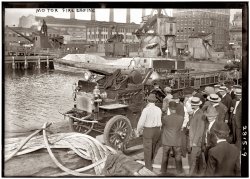
- Telluride: 1940
- ... that might mean putting something... different in your pipe.
Phoenix Bean This building looks to me like the current ... Posted by Dave - 09/30/2018 - 7:49am -
![Telluride: 1940 September 1940. "Dilapidated buildings at Telluride, Colorado." Medium format negative by Russell Lee for the Farm Security Administration. View full size.
This Property is Condemned. Part OneJust needs a leading man in the scene. Replayed everywhere in the USA.
It's all in how you say itA certain conductor, as his Rio Grande Southern train approached the town, would go through the coach and announce the next stop as, "To Hell You Ride".
Our young damsel in the photo looks like she'd rather be somewhere else. Hope she's in a better place now.
705 is really 205The address sign that looks to me like "705" is probably really "205." As in 205 E. Colorado Avenue. The vacant building with the suspicious young lady sitting in front is now gone, and they seem to have raised the street level, but the shop to the left is still there. In the 2014 Google view it's the "Telluride Music Co." but appears to be a cafe now. You might still be able to get a Big Smile there, but these days that might mean putting something... different in your pipe.
Phoenix BeanThis building looks to me like the current Phoenix Bean coffee shop (image below). It was originally a hardware store.
[This is the building to the left, with the SHERIDAN BEER sign in the window. - Dave]
Google and Bing say "no"I thought it would be interesting to see if these buildings survived the "gentrification" of Telluride after it became a ski resort, however, neither Bing nor Google maps have street view in Telluride. Hard to believe, but true.
Except for one small strip of Colorado Avenue (about a block) Google does not show any streetviews for Telluride in my Google in Indiana. Yet I see one below. WTF Google in Indiana?
Been to Telluride It's come up in the world.
NestsOn the more ornate building there a few nests above the girl. I will guess they are from wasps but the opening looks different than what I usually see.
[Those are swallow nests. Made by birds, not bees. - Dave]
(The Gallery, Russell Lee, Stores & Markets)](https://www.shorpy.com/files/images/SHORPY-8b26105a.thumbnail.jpg)
- Delta Psi: 1908
- ... were almost ready to underground in those vitreous clay pipe sections. The catalog page here is from a 1926 Western Electric Supply ... Posted by Dave - 05/14/2018 - 7:25pm -
![Delta Psi: 1908 New Haven, Conn., circa 1908. "Delta Psi fraternity house, Yale University." Note the Fire Alarm Telegraph Station at right. 8x10 glass negative. View full size.
Single-duct conduitI had a feeling the piled tubes were for underground conduit and suspect that new power wires were about to be strung to provide power to the buildings were almost ready to underground in those vitreous clay pipe sections. The catalog page here is from a 1926 Western Electric Supply Catalog and shows one example that matches the conduit in the Shorpy photograph.
F.A.T.S.Fire Alarm Telegraph Station 28.
Frat House PranksTo minimize the temptation to trigger a false alarm they made it difficult to open the box. Hopefully those two posted locations are available 24/7 to get the key.
Pipes PerhapsWhat are those short tubular objects stacked up along the street in three places?
[Portents of an impending water main or sewer line project perhaps? -tterrace]
Bit of a remodel, since.The gate is still useful, though.
[More than a remodel; the building stood between 1894-1913; the gate was saved and reused. -tterrace]
Anti-False Alarm Device?There were at least two patented systems to discourage false alarms via telegraph boxes.
The earlier system required the person turning in the alarm to reach up through a hole in the bottom of the box to reach the trigger. When triggered, the box would handcuff you so that you could not run away before the FD arrived.
This early system was soon found to discourage people from turning in real alarms. Who would want to be handcuffed to a pole in front of a burning building?
The later system dispensed a single, portable handcuff onto the citizen's wrist - s/he could flee danger, but had to report to the F.D. to get the cuff unlocked from his/her wrist.
Perhaps some Shorpy Sleuth can research whether either of these concepts was deployed in New Haven. If not, I can't imagine how frustrating it would be to have to hunt down a key while my home burned!
A Master BoxI worked on a Gamewell municipal alarm system back in the 1980s. That system is now just history and I am retired and, thankfully, not yet just history.
Institutions frequently had boxes inside buildings that controlled a remote but nearby "Master" box, which I am guessing is what we have here. Inside the Master box was a code-wheel, a small wheel with teeth that interrupted a direct current circuit connected to a central alarm office with a pattern corresponding to the Master's number, in this case, 28.
The code wheel was turned by a spring-driven mechanism, used because a spring did not need electrical power to run. The mechanism was held in a locked position by a pin. When a user activated a box inside the building, a local direct-current circuit activated a relay inside the Master box that pulled the pin from the locking position, permitting the code-wheel to turn and tap out its number on the central alarm office circuit.
The Master typically transmitted its code three times, and then the locking pin was pushed back into the mechanism. When firefighters had finished their job they'd unlock the Master Box and rewind the spring to prepare it for its next use.
It's just amazingThe stuff you learn here on Shorpy.
(The Gallery, DPC)](https://www.shorpy.com/files/images/SHORPY-4a19635a.thumbnail.jpg)
- Young Pioneers: 1940
- ... and the girl hoisting herself out of the water on the pipe ladder apparatus, the water leaping to her feet. (And the amount of ... Posted by Dave - 08/08/2018 - 6:39pm -
![Young Pioneers: 1940 May 1940. "Youngsters in the swimming pool at the desert dude ranch at Coolidge, Arizona." Medium format negative by Russell Lee for the FSA. View full size.
Roof Diving!Not recommended unless you're a daredevil.
Boys will be boys!How much ya wanna bet those boys on the roof are gonna jump from there into the pool?
Pretty fit groupExcept for the kid on the diving board, not much body fat among this crew.
Physical FitnessAmazing how fit and trim looking are the young men in the picture.
A matter of perspective.The first thing I wondered when I saw the photo was why they were on the poolhouse roof.
Looking closely, it appears they would have to take a running leap and sail over a lot of concrete to make it to the pool.
I'm STILL wondering why they were on the poolhouse roof.
Stop motionThree beautiful frozen moments of action: the boy at the back of the roof with his foot in the air; the sideways arc off the diving board; and the girl hoisting herself out of the water on the pipe ladder apparatus, the water leaping to her feet. (And the amount of concrete to be covered by a flying leap from the roof? Look at the distance from the base of the pole under the boy at the corner edge. Four feet, tops?)
What the heck is he doing?Did anyone else notice the boy directly behind the mid-air diver. It looks like he's getting ready to jump off the back side of the pool house. Another pool? ...A trampoline?
[Look for his left foot. He's stepping onto the top section of the roof. - Dave]
(The Gallery, Russell Lee, Swimming)](https://www.shorpy.com/files/images/SHORPY-8b24928a.thumbnail.jpg)
- Tales of Tarrytown: 1913
- ... was the home of F. J. Kaldenberg, the first meerschaum pipe manufacturer in the U. S. He died the year before this photo was taken. ... Posted by Dave - 05/04/2014 - 11:27pm -
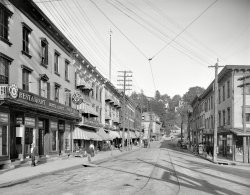
- Tin and Bones: 1920
- ...
Muffler Bearing I believe the muffler and header pipe are seen rather than a driveshaft center support bearing as mentioned by ... Posted by Dave - 05/13/2015 - 4:18am -
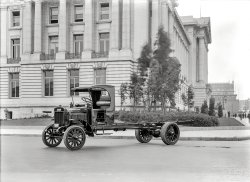
- Local Characters: 1938
- ... the woman. I failed to find the right "Drysmoke" tobacco pipe stand, the same for the "Sun Glasses" stand with the "hanging" sun ... Posted by Dave - 11/27/2017 - 11:43am -
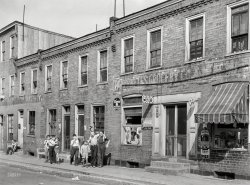
- Work, Read, Wash: 1943
- ... illegal now, as it can siphon the trap dry. The vent pipe connection must be only a foot or so below the sink, with the "J Trap" in ... Posted by Dave - 07/29/2016 - 8:13pm -
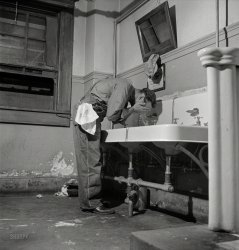
- High Water: 1900
- ... This is called a standpipe. It is basically a large pipe stood on its end. It provides some water storage volume but is mainly used ... Posted by Dave - 08/14/2012 - 2:12pm -
![High Water: 1900 Circa 1900. "Water tower in Dwight, Illinois." Unusual columnar design with a brick base, topped off by a weather vane and lights -- a sort of smokestack-lighthouse-watertower hybrid. Detroit Publishing glass negative. View full size.
Pressure would be higherIt would be higher pressure because the pressure depends upon the weight of all the water above the output area. Although the volume of water could be the same as a short fat tank, the depth would be less in a short fat tank, hence a smaller amount of water above the output.
A tale of two cylindersI am no expert on water-pressure physics, but it seems like a "tall" column-style tank like this would give more water pressure than a shorter, fatter cylinder of the same volume. Or is that just misleading intuitive thinking? The weight of the water would be the same, after all.
[I think your hunch is correct. The weight of the water over the drain (or water pressure, expressed as weight divided by area, for example pounds per square inch) would be greater in a tall, relatively thin (columnar) cylinder. - Dave]
Tower for SaleThere's a similar brick water tower (minus the tank) for sale in Raleigh, NC. Built in 1887, it's on the National Register. Yours for a cool $685,000.
What is that upside down funnel thingLooks to be hanging from the wires.
[It's a carbon-arc lamp. - Dave]
Also for those not used to such things, that farm implement at the base of the water tower is a mower. Could be used for hay, or wheat or just grass. Used my grandpa's many a time back in the '60s.
Big towerThe Fostoria, Ohio, water plant still has a base, made of stone, but the upper part is gone. It too was similar, but the water was not potable, rather only for fire suppression. Old photos show the tower was taller than the base.
StandpipeThis is called a standpipe. It is basically a large pipe stood on its end. It provides some water storage volume but is mainly used to increase the pressure in the water system without having to constantly run a pump.
(The Gallery, DPC)](https://www.shorpy.com/files/images/4a20231a.thumbnail.jpg)
- Chinese Opera House: 1908
- ... by one that's shorter. Comparing the bottom of that sewer pipe, I'd say the street has gotten thicker.
(The Gallery, G.G. Bain, NYC) ... Posted by Dave - 08/19/2012 - 3:15pm -
![Chinese Opera House: 1908 New York, 1908. "The Chinese Opera House." 5-7 Doyers Street. 8x10 glass negative, George Grantham Bain Collection, Library of Congress. View full size.
Gritty TextureFans of gritty texture and realer-than-real detail should immediately go to the large view. Great study.
[Also note the two women in the window. - Dave]
Chinese Opera HouseThis is 5 Doyers Street between the Bowery and Pell Street, right along the Bloody Angle. Here’s a current view of the site.
5-7 Doyers, the former Opera House, is now CC Fashion. Click to enlarge.
[Fascinating. A hundred years later the bottom section of that cast-iron drainpipe is still there. - Dave]
Street, meet sidewalkLooks like either the street has grown taller over the years or the sidewalk has been replaced by one that's shorter. Comparing the bottom of that sewer pipe, I'd say the street has gotten thicker.
(The Gallery, G.G. Bain, NYC)](https://www.shorpy.com/files/images/01390u.thumbnail.jpg)
- The Old Bus: 1937
- ... prairie winds. And yeah, I'd bet didn't have a stove or a pipe.
Thanks for a look at a vehicle I'd never heard of--a horse-drawn ... Posted by Dave - 01/31/2013 - 10:33am -
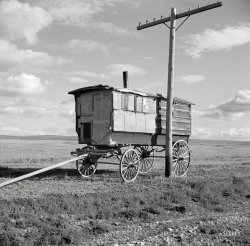
- Diapers Online: 1941
- ... getting sick from this siding on one's house. Asbestos pipe insulation on the other hand is nasty and a whole other story.
... Posted by Dave - 11/18/2012 - 2:20pm -
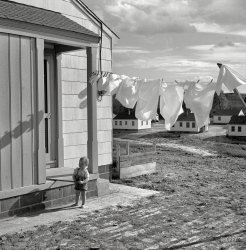
- Santa Claus Time: 1921
- ... Aeolian's success with its Pianola player piano and pipe organs.
It is interesting that this shop is selling the ... Posted by Dave - 09/13/2011 - 11:53pm -
